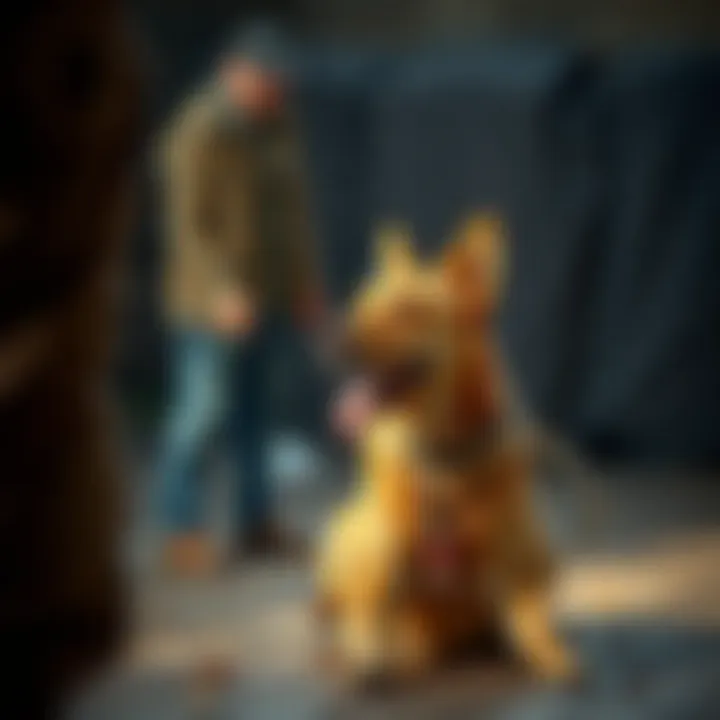Training Your Dog for Home Protection: Effective Techniques


Intro
Training a dog for home protection might seem like a daunting endeavor, but with the right approach and understanding, it can be effectively achieved. The bond between a pet and its owner is nurtured through training, trust, and companionship. When it comes to safeguarding your living space, a well-trained dog can provide not only security but also a sense of comfort knowing that you have a reliable guardian by your side.
In today's world, where safety concerns loom larger, many dog owners are seeking ways to ensure that their pets can serve as protectors. This need is crucial, especially as homes become more than just places to reside. They are sanctuaries, and safeguarding these havens is paramount. The training journey is more than just teaching commands; it's about cultivating an awareness of a dog’s natural instincts, reinforcing behaviors through consistency, and maintaining a harmonious relationship.
Understanding canine behavior is an integral part of the training process. Rather than treating protection training as a standardized procedure, it's essential to recognize each dog's unique personality. From the energetic Mastiff to the vigilant German Shepherd, different breeds come with their own set of characteristics that influence how they can be trained for protective tasks.
Through this article, we will explore various strategies to train your dog in home protection, discuss safety measures to ensure a balance between protective instincts and companionship, and highlight engaging activities that can enhance your dog’s natural guarding tendencies without turning them into overly aggressive or anxious animals. By the end, you'll possess a comprehensive understanding of the training process, which utilizes both instinct and learned behavior to help your dog protect your home effectively.
Furthermore, we will delve into pet care considerations like grooming, health, behavioral training, and resources to create a well-rounded approach to fostering a protective yet balanced canine companion.
Understanding Dog Behavior
Understanding canine behavior is crucial for effective training, especially when it comes to preparing a dog for home protection. In this context, knowing how dogs think, react, and interact with their environment will not just enhance your training efforts, but it will also strengthen the bond between you and your canine companion. By being attuned to your dog's instincts, emotional states, and social habits, you can tailor your approach to foster a well-balanced and responsive guard dog.
The Nature of Canine Instincts
Dogs, by nature, are instinctual creatures with a rich tapestry of behaviors rooted in their ancestry. Their instincts serve as primary drivers for actions, often dictating how they respond to various stimuli. Some of their basic instincts include hunting, herding, and, importantly, guarding. Understanding these instincts helps in setting the stage for more focused training.
For example, some breeds such as the German Shepherd or Rottweiler already come wired with a propensity to protect. Recognizing a dog's intrinsic behaviors may offer incredible insight into how to harness those features through training. If a dog feels an innate need to protect, that characteristic must be nurtured correctly. A calm and assertive leadership from the owner is key here, as it directly influences how a dog interprets its environment and reacts to potential threats.
"A well-trained dog is guided by instinct and nurtured by understanding."
In addition, it's essential to acknowledge that each dog's instincts can vary widely, dependant on factors like breed, early experiences, and socialization. This complexity means every training exercise must take into account individual differences to be effective.
Identifying Protective Traits
Once you grasp the nature of canine instincts, the next step is to identify the protective traits within your dog. Recognizing these traits is a fundamental part of tailoring a training program that resonates personally with your dog. Signs of a protective nature might include cropping its ears, a low stance when alert, or even being vocal when it perceives a threat.
To pinpoint these behaviors, consider the following:
- Body Language: A dog's posture can tell you a lot. Are they standing tall with their ears perked up? This often indicates confidence and readiness to defend. Conversely, a hunched posture might suggest unease or fear.
- Vocalizations: Does your dog bark at strangers or unknown sounds? While barking can also be a sign of anxiety, the context matters significantly. Barks that are low and drawn out can indicate a sense of vigilance.
- Response to Threats: Observe how your dog reacts to new people entering your house. Does it keep a distance while watching closely, or does it show fear and back off? The former can be a sign of protective instincts, while the latter may necessitate further socialization.
By being mindful and observant, you can begin to identify these traits effectively, which allows for focused reinforcement during training. The balance lies in encouraging guarded behaviors without fostering unnecessary aggression or fear-based responses.
Assessing the Right Breed for Guarding
Choosing a breed suitable for guarding your home is paramount. Not all dogs are created equal, especially when it comes to their capabilities in terms of protection and guarding instincts. This section delves into essential factors to consider when assessing the right breed for your home protection needs. Knowing which breed aligns with your lifestyle and security requirements can make a world of difference. Ultimately, the goal is to select a dog that not only acts as a protector but also fits well into your family dynamics.
Breed Characteristics and Tendencies
Different dog breeds come with unique characteristics and tendencies that influence their guarding abilities. For instance, breeds like the German Shepherd and Rottweiler are often acknowledged for their loyalty and protective instincts. They tend to be alert, intelligent, and adaptable, which makes them excellent choices for guarding roles. Other breeds, like the Doberman Pinscher, are not only known for their robustness but also for their remarkable sense of duty towards their owners.
Traits to consider include:
- Size and Strength: Bigger breeds may physically deter intruders; however, smaller breeds can often be just as alert and vocal.
- Energy Levels: High-energy dogs may require more exercise but can excel in maintaining vigilance if adequately stimulated.
- Intelligence: Some breeds like Border Collies are highly trainable, allowing them to respond quickly to commands, which is crucial in a guarding scenario.
- Sensitivity to Environment: Some dogs are naturally more aware of their surroundings and can detect changes in routines or unfamiliar sounds, thus signaling potential threats.
It's clear that understanding these characteristics allows prospective owners to align their preferences with the breed’s strengths, enhancing the effectiveness of training and ensuring a suitable match for their home environment.
Temperament Considerations
The temperament of a dog plays a significant role in its capacity for guarding. It’s not just about being aggressive or protective; a balance of temperament traits encourages effective guarding behavior while maintaining a harmonious household. A dog with a sound temperament may be more discerning when it comes to assessing threats, rather than acting out of fear or anxiety.
When evaluating a breed's temperament, consider:
- Calmness: Dogs that exhibit a calm demeanor can be less reactive while still alert when necessary. This is crucial for a home environment.
- Loyalty: A loyal dog that forms strong bonds with the family is more likely to defend their home against perceived threats.
- Socialization Skills: A dog must be socialized not just with people but also with other animals. This reduces the chances of over-protection, where a dog might react aggressively in situations that don't require it.
- Trainability: Breeds that are eager to please and respond well to training are often better suited for homes requiring protective behavior.
"Selecting the right breed is not merely about looks or reputation; it’s about establishing a partnership that emphasizes trust, respect, and understanding."
Setting the Foundations for Training
Establishing Leadership and Trust
Canines, at their core, are pack animals; they thrive in social structures led by a confident leader. This dynamic is not just about authority; it's about fostering respect and trust. If your dog sees you as their owner but not as a leader, the training may face multiple hurdles.
The first step to establishing yourself as a leader is to be consistent in your commands and expectations. Dogs are creatures of habit, and they appreciate clear and predictable guidance. For example, if you command your dog to sit, and sometimes they are allowed to ignore it, it sends mixed signals that can confuse them.
Consider these key points when establishing leadership:
- Consistency is King: Always enforce the same rules and commands. If they learn they can sometimes get away with a behavior, they will test boundaries.
- Positive Reinforcement: Instead of relying on punishment, focus on rewarding good behavior. A simple "good boy" accompanied by a treat goes a long way in building a bond of trust.
- Time and Patience: Building trust doesn't happen overnight. It requires a strong commitment over time, leading to a more responsive and reliable companion.
"A dog will take a leap of faith if they trust their leader. Your actions shape their understanding of safety and commitment."
Creating a Positive Learning Environment
A positive learning environment is where training happens, and the dog feels safe, encouraged, and eager to engage. This environment directly impacts the efficiency of the training methods employed.
Start by ensuring that your training sessions are neither too long nor overwhelming. Short, focused training periods are often more productive. Here are some essential tips for creating that environment:
- Choose the Right Location: Training should not be done in places filled with distractions. Opt for secure spaces, like your yard or a quiet park, where your dog can concentrate.
- Use Engaging Tools: Whether it’s colorful toys or delectable treats, make training fun. The more enjoyable the training, the more your dog associates learning with positive experiences.
- Monitor Emotional State: If your dog seems anxious or frustrated, take a step back. The goal is to encourage enthusiasm for learning, not to instill fear.
Basic Obedience Training
Basic obedience training is the backbone of a well-rounded training regimen for guard dogs. It sets the stage for more advanced protective behaviors and ensures that your canine companion knows how to respond to commands. Without these core teachings, a dog may not be able to differentiate between harmless situations and potential threats, which can lead to confusion and, ultimately, risk for both the dog and its owner.
One of the primary benefits of basic obedience training is the establishment of communication between you and your dog. When your dog understands commands like "sit," "stay," and "come," they are better equipped to follow your lead in various situations. This level of familiarity builds trust, which is essential for effective training, especially in the context of home protection.
Essential Commands for Guard Dogs
When preparing a dog for guarding responsibilities, specific commands become indispensable. Here’s a look at some vital commands:
- Sit: A basic command that acts as a building block for other behaviors. When a dog sits, it shows they are in control, which is beneficial when assessing a situation.
- Stay: This command helps your dog maintain their position, crucial when you need them to hold their ground to deter threats.
- Come: A life-saving command that ensures your dog returns to you quickly, especially in emergency situations.
- Leave it: This command teaches your dog to ignore distractions, which could avert unnecessary altercations.
- Watch: This command instructs your dog to be vigilant, looking out for anything unusual around the home.


Each command serves a distinct purpose and empowers your dog to perform effectively in guarding roles, all while enhancing safety for the household.
Consistency in Command Training
Now, let's tackle the nitty-gritty of why consistency is paramount in command training. Picture this: you've taught your dog to sit on command, but you sometimes use a different tone or allow them to decide when to listen. Such mixed signals can lead to confusion, making it less likely for them to respond when it really matters.
Training should follow a structured routine where commands are issued in the same way each time. Here are some points to consider for maintaining consistency:
- Same Tone and Body Language: Use the same firm but friendly tone and similar gestures each time, so your dog knows what you expect.
- Reinforce Regularly: Incorporate daily practice into your routine. A few minutes each day can keep your dog sharp and ready to comply.
- Family Involvement: Ensure that every family member uses the same commands and expectations. This collective approach removes any ambiguity that could otherwise confuse your dog.
Training is as much about your commitment as it is your dog's learning. A well-trained dog is not just a protector but also a beloved family member that knows its place.
"A dog is the only thing on earth that loves you more than he loves himself."
By understanding and implementing basic obedience training effectively, you set up a solid foundation for what lies ahead in your dog's guarding capabilities. The road to a well-trained guard dog might be long, but every step is worth it for peace of mind and security.
Introducing Guard Dog Training Techniques
Training a dog to be a protector is no small feat; it requires a thoughtful approach and a deep understanding of canine behavior. Introducing guard dog training techniques serves as a crucial phase in ensuring that your dog not only becomes an effective guardian but also maintains a healthy demeanor. The span between a dog being playful and protective is thin, and navigating this path is essential for creating a harmonious atmosphere at home. In this section, we will explore how to build alertness and awareness first, then delve into the nuances of controlled aggression training.
Building Alertness and Awareness
Alertness and awareness are the cornerstones of effective guard dog training. If you want your furry friend to act as more than just a couch potato, instilling a keen sense of awareness is a must. When a dog is alert, it can respond effectively to potential threats, whether they be an unknown visitor at the door or a suspicious sound outside.
- Interactive Exercises: Engage your dog in activities that stimulate their senses. Games like hide and seek can be effective; while hidden treats build focus and tracking instincts.
- Obedience Reinforcement: Commands such as "stay" or "watch" help your dog learn to focus on you and their environment. If your dog is used to obeying basic commands, they’ll be better equipped to remain vigilant.
- Environmental Exposure: Spend time outside in various settings. This helps your dog become accustomed to different noises and sights. Gradually introducing your dog to busy public places can build their confidence and alertness levels.
It’s worth mentioning that too much stimulation from the environment can overwhelm some breeds, leading to anxiety or fear. Therefore, monitoring your dog’s response during these exercises is critical.
"A watchful eye is as good as a watchdog."
Controlled Aggression Training
Adding a layer of controlled aggression to your dog’s training regimen is vital for developing a comprehensive protector. This doesn’t mean encouraging mindless biting or uncontrollable barking; rather, it’s about teaching your dog when it’s appropriate to respond aggressively to a true threat.
- Defining Triggers: Start by identifying what your dog will perceive as threats. This could be a person approaching your property or unusual noises. Help your dog learn to differentiate between normal stimuli and potential dangers.
- Setting Boundaries: Commands such as "leave it" and "down" can be trained under various scenarios. This establishes a clear behavior expectation, allowing your dog to learn how to respond appropriately.
- Controlled Exposure: Introduce your dog to mock threats in a controlled environment. For instance, you could use a friend to simulate an intruder scenario. Reward your dog for appropriate reactions to this training, emphasizing calm and assertive behavior over irrational fear.
- Positive Reinforcement: Celebrate small victories when your dog reacts appropriately. Offering treats or praise not only solidifies desired behaviors but also creates a positive association with protective actions.
In essence, controlled aggression is about harnessing your dog’s natural instincts in a way that ensures safety without going overboard. Addressing this aspect with care and caution will make for a much more balanced protector in the long run.
Utilizing Positive Reinforcement
Positive reinforcement ensures that training isn't just about correcting behaviors but about celebrating successes. Every treat, verbal praise, or pat combined reinforces the bond between you and your dog. This bonding is especially critical for guard dogs, who must differentiate between real threats and harmless situations. When they know they will be rewarded for their keen observations or protective actions, they are far more likely to perform these tasks willingly.
Reward-Based Techniques
Implementing reward-based techniques in training can be a game changer. It's about finding what motivates your dog most—whether it’s treats, toys, or even a vigorous game of fetch. Here are some effective methods:
- Timing is key: Rewards must be given immediately after the desired behavior occurs to reinforce the action correctly.
- Higher-value treats: Use special treats that your dog doesn’t get regularly. This adds value to the behavior you want to encourage.
- Variety in rewards: Change up your reward system—sometimes use treats, and other times use playtime or affection. This keeps the training interesting for your dog.
The goal is to create an association in your dog’s mind that positive behavior, especially related to protecting the home, leads to positive outcomes for them. This way, when your dog barks at a passerby or stays vigilant, they do so not out of fear but because they know they’ll gain something in return.
Motivating Your Dog During Training
Keeping your dog motivated throughout training is essential for success. It’s not always easy—some days are better than others, and dogs can easily get bored. Here are some techniques to maintain motivation:
- Short, engaging sessions: Dogs often have short attention spans, so aim for brief, focused training sessions, ideally around 10-15 minutes.
- Incorporate play: Integrate play into training. For instance, a quick game of tug can follow a successful session, reinforcing the fun aspect of learning.
- Set achievable goals: Start with simple tasks, and gradually increase the complexity. This prevents discouragement and keeps both you and your dog engaged.
“Training is not just about teaching commands; it’s about connecting on a deeper level.”
Additionally, observe your dog’s body language closely. If they seem disinterested or frustrated, consider adjusting your approach. Every dog is unique, and sometimes a simple change in the type of reward or training method can reignite their enthusiasm.
Simulating Real-World Scenarios
Training a dog for home protection isn’t just about teaching commands; it’s also about preparing them for real-life situations. Simulating realistic scenarios helps a dog to understand what is expected of them in critical moments. This practice goes beyond mere obedience; it builds confidence and sharpens instincts. By creating environments that mirror potential threats, you provide dogs with the tools they need to discern between everyday noises and actual intrusions.
Practicing these scenarios is essential for several reasons:
- Builds Familiarity: When dogs are exposed to mock intruders or scenarios mimicking disturbances, they become accustomed to the sounds and sights associated with these situations. This prevents confusion and anxiety during real occurrences.
- Enhances Reaction Timing: Controlled exercises help dogs learn how to react quickly and appropriately. Instead of barking at every doorbell or passerby, they learn to assess the context and respond to real threats more efficiently.
- Strengthens Handler Communication: Conducting these simulations allows handlers to better communicate with their dogs. This improves mutual understanding. Instead of relying solely on commands, both dog and owner learn to read each other’s cues during tense moments.
In training, you want the end goal to be a balanced protector. The dog should exhibit protective qualities without becoming overly aggressive or fearful. Therefore, it’s crucial to approach these simulations with care, ensuring your canine remains calm and well-trained after each exercise.
"Training methods that augment realistic responses lead to dogs that are reliable and less prone to fear-based reactions."
As we delve into the specifics, we will now explore two pivotal types of real-world simulations: mock intruder exercises and desensitization techniques.
Mock Intruder Exercises
Mock intruder exercises should be designed thoughtfully, mimicking conditions under which a real-life threat might occur. These practice sessions could involve a friend or family member dressed in casual attire, creating a situation where they attempt to enter your home uninvited. The key is to control the environment, ensuring safety for both the dog and the person acting as the intruder.
Here’s what to consider during mock intruder exercises:
- Choice of Location: Start in a familiar setting where the dog feels secure. Ideally, this should be at home. This helps to build confidence and reduces the chance of stress.
- Gradual Introduction: Initially, ensure the intruder is not overtly threatening. Simple actions like knocking on the door or walking near the window can introduce the idea of a potential intrusion. Gradually escalate to more challenging scenarios.
- Rewards for Good Behavior: As the dog successfully identifies or reacts to the mock intruder, reward them with treats or praise. This positive reinforcement solidifies desired behaviors and helps create a strong association between actions and rewards.
Incorporating these exercises will help establish the dog's instinctive protective behaviors while allowing them to understand boundaries and when it’s appropriate to react.
Desensitization Techniques
Desensitization is a crucial element in preparing your dog for the unexpected. While some dogs may react aggressively or with fear to unfamiliar sounds or movements, desensitization techniques aim to reduce these reactions by exposing them gradually to various stimuli that might evoke fear or anxiety.
Desensitization can include:
- Sound Exposure: Play recordings of various noises like doorbells, shouting, or even sounds that mimic trespassing. Start with low volumes and gradually increase as the dog becomes comfortable.
- Controlled Exposure to Strangers: Invite friends or neighbors to approach your property while you have your dog leashed. Encourage them to ignore the dog initially, allowing your pet to assess the situation without pressure.
- Consistency in Routine: Combine these techniques with regular training sessions. A well-structured routine helps to keep your dog calm and focused, making them more likely to accept new experiences without fear.
Through consistent application of desensitization techniques, you can help your dog learn how to navigate the uncomfortable or unpredictable events they may face in the real world, ensuring they are not overwhelmed or confused when the actual situation arises.


The Role of Socialization in Guard Training
Socialization plays a crucial part in preparing your dog for effectively guarding your home while maintaining a balanced temperament. The notion of a guard dog often conjures images of aggressive canines ready to protect their territory at a moment's notice. However, pouring all that energy into training without proper socialization may lead a dog to develop unwanted behaviors, such as excessive anxiety or unwarranted aggression towards harmless visitors. It's vital to consider that successful guard dogs must be perceptive enough to distinguish between genuine threats and friendly faces.
Integrating with Other Animals and People
To ensure a well-rounded guard dog, exposing your canine to various people and animals during its formative stages is essential. This increased exposure helps your dog learn to decipher social cues, recognize non-threatening behavior, and develop appropriate responses. Idea of mixing your pup with various breeds or sizes of other dogs can reduce the likelihood of fear-based reactions when faced with unfamiliar pups later on. Moreover, integrating your dog with people of diverse ages, genders, and appearances, promotes comfort and reduces the chance of fear-induced aggression.
Additionally, engaging your dog in social settings can significantly enhance its confidence. When a dog learns to interact positively in a variety of environments, it can better cope with possible intruders without falling into a state of panic or overreacting. This familiarity becomes something like a safety net, allowing the dog to feel secure and composed when faced with real threats. Therefore, rather than relegating your dog solely to protection training, remember that well-rounded socialization is an equally important aspect.
Avoiding Over-Protection Behaviors
Overprotection can be a double-edged sword. While you want your guard dog to be vigilant, excessive protectiveness can manifest in problematic ways. Without proper socialization, a dog might perceive any new person or animal as an intruder, risking hostility towards all unfamiliar guests even in non-threatening situations. This can lead to situations that escalate quickly and could put everyone involved in danger.
To mitigate this risk, it's critical to teach your dog clear boundaries regarding what constitutes acceptable behavior towards strangers. This can be achieved through consistent commands and controlled social interactions. Remember the folks who pop by for a quick visit? Teach your dog to greet newcomers politely, rewarding calm behavior with treats or praise. Additionally, employing positive reinforcement techniques can be key to steering your dog away from fostering overly aggressive tendencies. Regular training sessions should focus on reinforcing good behavior, whether it's through sit, stay, or leave it commands.
Incorporating these techniques into your guard dog training assembles a well-rounded protector. A balanced dog develops the ability to think for itself and gauge situations appropriately, reducing the likelihood of mishaps and misunderstandings. This, ultimately, allows for a more harmonious atmosphere at home.
Socializing a guard dog isn’t just about keeping it friendly; it's about building a bridge between instinct and learned behavior. Developing a nuanced approach is key.
Dealing with Behavioral Issues
Training a dog for home protection involves more than just teaching commands or aggressive behaviors. It’s critical to recognize that behavioral issues can arise, potentially undermining the dog’s training and harming the relationship with its owner. This section delves into the importance of identifying and addressing these issues to ensure the dog remains a reliable protector without losing its temperament or becoming a danger to bystanders.
Incorporating effective strategies to tackle behavioral issues helps in nurturing a dog that can discern between real threats and everyday situations, thus enhancing its protective instincts in a controlled manner. Understanding your dog's behavior can pave the way toward building a solid foundation of trust and consistency, crucial for both the owner and the dog.
Identifying Signs of Anxiety or Aggression
Recognizing the signs of anxiety or aggression in dogs is the first step toward effective training. Dogs often communicate feelings through body language or vocalizations; paying careful attention can save you from potential threats down the line. Here are some signs to look out for:
- Body Language: A dog may exhibit tension in its body, lowered ears, a stiff tail, or a tail tucked between its legs. Any signs of discomfort are a call for immediate attention.
- Vocalizations: Barking, growling, or whimpering may signal fear or a readiness to assert dominance. Distinguishing between playful barking and alarm barking is vital in understanding your dog’s emotional state.
- Avoidance Behavior: If your dog is hiding or trying to escape from situations that previously did not bother it, there may be underlying anxiety that needs to be addressed.
Addressing these issues promptly can help to implement an effective training regimen tailored specifically for your dog’s needs. Taking the time to understand these signs can strengthen the bond between you and your pet, ensuring a safe environment for both.
Consulting Professional Trainers
If the signs of anxiety or aggression are more than you can handle, consulting with a professional trainer might be necessary. Professional trainers can offer specialized insight into behavioral issues and help create a training program suited for your dog’s specific challenges. Here are several factors to consider when seeking professional help:
- Qualifications: Look for trainers certified in canine behavior and training. They should ideally have experience in dealing with protection dogs.
- Methods Used: Inquire about the training techniques employed. Positive reinforcement methods are generally preferred, minimizing stress and reinforcing desirable behaviors.
- Evaluations: A reputable trainer will conduct thorough evaluations, looking at your dog’s behavior, background, and environment. This comprehensive assessment ensures tailored training that addresses unique concerns.
Investing in professional training can be beneficial, both in resolving current behavioral issues and in preventing future ones. By partnering with a knowledgeable trainer, you empower your dog with the skills needed for effective protection while ensuring its emotional health remains intact.
"Understanding your dog's behavior is crucial to ensuring training is not only effective but also safe for your canine companion."
Recognizing and addressing behavioral issues shapes the way your dog learns and grows. It enables your canine companion to transition successfully into a reliable protector, free from the constraints of anxiety or untamed aggression. By staying informed and proactive, you craft not just a secure environment but also a trusting relationship that defines a fulfilling journey together.
Safety Considerations for Guard Dogs
When it comes to training dogs for protection roles, safety should be the cornerstone of your approach. Engaging in certain training methods can inadvertently shape behaviors that are not only unwanted but can also lead to dangerous situations. Understanding the dynamics of training a guard dog with regard to safety can prevent potential legal issues and ensure that the dog remains a trusted companion.
Preventing Unwanted Aggression
One of the main concerns that arise during the training of a guard dog is the risk of unwanted aggression. While a dog must learn to protect, it shouldn't cross the line into being a threat to family members or invited guests. Here are some strategies to keep aggressive impulses in check:
- Socialization: Let's not play it fast and loose with the dog's interactions. Regular, positive exposure to different people and animals will help the dog distinguish between who is a friend and who might pose a threat.
- Training Consistency: A dog thrives on consistency. If you constantly change the commands or the rules, they become confused. This confusion can lead to anxiety, which may spawn aggression. Stick to your methods and reinforce them daily.
- Use of Commands: Teach commands that explicitly signal when to escalate or de-escalate behavior. Commands like "leave it" or "quiet" can help manage impulses effectively.
The goal is to instill confidence and obedience in your guard dog, ensuring that it acts appropriately during high-stress situations rather than reacting on instincts alone.
Establishing Safe Boundaries
Creating secure environments ensures that your dog understands its limits. Setting boundaries effectively involves training but also physical aspects of the home. Below are some critical considerations for establishing safe boundaries:
- Defined Areas of Authority: Clearly define which areas of your home are off-limits for the dog unless instructed otherwise. This teaches them that there are designated spaces where they must exercise control.
- Fenced Yard: If your canine protector will spend time outside, a sturdy fence is essential. Depending on the breed, they may have high prey drives, and a fence reduces the chances of them chasing after movements beyond its confines.
- Controlled Access to Visitors: Have specific commands that guide your dog about who can enter the household. Use secure holding spaces for your dog when unfamiliar people come over to maintain safety and prevent unwarranted reactions.
Incorporating these practices ensures that your dog not only operates within the parameters you've set but also understands the role it must fulfill without becoming unpredictable.
"A dog is the only thing on earth that loves you more than he loves himself." — Josh Billings
In summary, safety considerations in guard dog training are multi-faceted. By preventing undesirable aggression and establishing rigid boundaries, you can ensure that your dog serves its protective role while remaining a loving member of the family. Without these safeguards, there's always a risk that the training could lead to consequences that neither the dog nor its owner intended. Being aware of such dynamics not only protects your home but fosters a healthier bond with your canine companion.
For more insights on proper training and safety, consider visiting American Kennel Club or check out resources on dog behavior studies.
Reinforcing Training Throughout Life
Training a dog for home protection is not a one-and-done deal. It’s an ongoing journey that benefits from consistent reinforcement. Just like people, dogs need continual practice and reminders to maintain their skills and adapt as they age. By actively engaging in ongoing training, owners can ensure that their dog remains alert, responsive, and well-behaved.
Ongoing Training Practices
Regular training sessions should be integrated into the dog's life to keep skills sharp. Here are a few elements to consider:
- Frequency: It's important to train often, but the sessions don’t have to be marathon. Short, daily training exercises can be more effective than occasional long sessions. Once a dog learns a basic command, practicing it a few times a week can help solidify the behavior.
- Variety: To keep things fresh, incorporate new commands or challenges. This can prevent your dog from becoming bored with routine and can even strengthen their learning. For example, you might start mixing up where you hide treats or introducing agility items to navigate.
- Real-life Situations: Engaging in training during walks or involving distractions like other dogs and people can familiarize your guard dog to environments they may encounter in real life, further enhancing their protective instincts.
Remember, even after mastering a command, consistency in practice is vital. A dog that doesn't frequently use its skills may start to forget them over time.
Adapting Training for Aging Dogs
As dogs age, their physical capabilities and mental sharpness change, and training should evolve likewise. Here’s how to adapt:
- Adjusting Expectations: It's crucial to recognize that older dogs may not respond as quickly or with the same intensity as younger ones. Instead of focusing on peak performance, aim for steady engagement at their own pace.
- Light Exercises: Older dogs may benefit from gentler training regimens. Short and simple exercises, like basic commands or light agility work, can be easier on their joints.
- Mental Stimulation: Keeping the mind engaged is essential for senior dogs. Puzzle toys, scent games, and interactive play can provide a different type of exercise that can still assert their role as a protector without physical strain.
In summary, ongoing training throughout a dog's life lays the groundwork for a reliable guardian. As the dog ages, understanding and adjusting the training methods to suit their capabilities ensures that they remain secure and diligent protectors for years to come.
"Ignoring a dog's learning process over time can lead to a few rusty skills or unwanted behaviors. Reinforcement is key not just for training but for the bond between you two."


Legal Considerations for Guard Dogs
Understanding Liability Issues
Liability does not merely pertain to damages that your dog may cause; it extends to potential injuries that might occur during training or while your dog is guarding your home. For instance, if your dog bites a visitor or an intruder, you could be held accountable for their actions. Many states follow a strict liability policy, meaning an owner is responsible for any harm caused by their dog, regardless of the animal’s past behavior.
A few key factors play into this:
- Dog Breed: Certain breeds may carry a reputation that can influence liability in a legal setting. For instance, if your guard dog is a German Shepherd or Rottweiler, it might come under closer scrutiny in case of a bite incident.
- History of Behavior: If your dog has a history of aggression, that may complicate your case. It’s best to document their behavior and consult a legal expert if necessary.
- State Laws: Each state has its own laws regarding dog ownership and liability. Familiarize yourself with these laws to avoid any nasty surprises.
"Knowledge is not only power; it's also protection. Know the laws in your state to safeguard your interests and those of your dog."
Consulting with a lawyer skilled in animal law can provide you clarity and guidance. They can help you understand statutes and precedents that may affect your rights as a dog owner.
Regulations for Guard Dogs
In addition to liability, there are specific regulations concerning guard dogs that every owner should be aware of. These laws can vary widely by jurisdiction, so the importance of local research cannot be overemphasized. Many cities and towns have ordinances that dictate how a guard dog should be trained, contained, and managed.
Key regulations to consider include:
- Certification Requirements: Some areas may require guard dogs to be certified by a trainer or organization specializing in protection dogs. This certification often ensures that the dog is trained safely and effectively.
- Confinement Measures: Many jurisdictions have laws that outline how and when a guard dog can be kept outdoors, often mandating secure fencing or leash requirements.
- Insurance Policies: It might come as a surprise, but some homeowners' insurance policies have stipulations regarding guard dogs. Be sure to talk to your insurance provider about how your dog’s breed and training status affect your coverage.
- Residential Zoning: Depending on where you live, there might be zoning laws that restrict the type of animals you can own. It’s not uncommon for homes in suburban areas to have limitations concerning guard animals.
By carefully considering these legal aspects, you can train your dog while remaining compliant with local and state rules, minimizing risks to yourself and your companion. Taking the time to educate yourself leads to a more enriching experience not just in training, but in pet ownership overall.
The Bond Between Owner and Dog
In the journey of training a dog for home protection, the relationship between the owner and the dog can be a pivotal factor. This bond is not just about companionship; it's fundamental in developing a sense of trust, ensuring that the dog perceives the owner as a leader and a protector. When a strong connection exists, it positively influences the training process and enhances the effectiveness of protective behaviors.
Dogs are social animals. They thrive on interaction and engagement. By fostering a nurturing and supportive environment, owners facilitate a learning atmosphere where dogs feel secure enough to explore, learn, and ultimately protect. For a dog to be effective in guarding home, it must not only trust its handler but also recognize that the owner has its best interests at heart. This mutual understanding lays the groundwork for impactful training sessions.
- Benefits of a Strong Bond
- Enhanced communication: Dogs can read human emotions and body language. A strong bond allows for clearer cues during training.
- Improved obedience: Trust leads to higher compliance to commands, making training smoother and more effective.
- Increased confidence: A dog that trusts its owner is likely to exhibit more self-assurance, especially in perceived threatening situations.
- Reduced anxiety: A reliable bond lowers stress levels in dogs, which is vital for maintaining focus on training tasks.
In a nutshell, the depth of the bond between owner and dog serves not only as a foundation for effective training but also as a crucial element in ensuring safety and security at home.
Enhancing Trust Through Training
Building trust starts with understanding your dog’s perspective. Training should be approached with patience and consistency. Dogs are keen observers and will imprint on experiences that are either positive or negative. Here are some effective techniques to enhance that trust:
- Start Slow: Before diving into complex obedience or guard training, engage in simple exercises that promote cooperation. Basic commands like sit, stay, and come are foundational. When these commands are mastered, dogs become more attuned to their owner's expectations.
- Use Positive Reinforcement: When the dog performs a desired behavior, reward it. This can be with treats, praise, or play. Positive reinforcement fosters an environment where dogs feel secure and valued, solidifying trust.
- Adopt Consistency: Dogs respond well to routines. Regularly scheduled training sessions help establish predictability, which can further enhance trust. If there's a consistent structure, the dog learns that it can depend on its owner for guidance.
Recognizing the Dog's Needs
To create an effective protector, it’s crucial to recognize and attend to your dog’s needs. A well-rounded dog is more likely to engage positively in their training. Here are some critical elements to consider:
- Physical Needs: Ensure that your dog gets adequate exercise. An energized dog will focus better and exhibit more enthusiasm during training.
- Mental Stimulation: Engage your dog in puzzles or games to keep their mind sharp. This can also include obedience training as a form of mental workout.
- Emotional Needs: Dogs thrive on companionship. Spend quality time with your dog outside of training. They should feel like valued members of the family.
- Health Considerations: Regular check-ups and a healthy diet are essential. When a dog feels physically good, it displays a better attitude during training.
"The love for a dog encompasses far more than mere companionship; it encompasses responsibility, understanding, and a deep connection that enhances life quality for both dog and owner."
Meeting these needs while maintaining a focus on training lays the groundwork for the dog's role as a protector of your home, allowing the bond to flourish in the process.
Common Myths About Guard Dogs
Understanding the common myths surrounding guard dogs is crucial for any dog owner or prospective pet adopter looking to incorporate a protective canine into their lives. Debunking these misconceptions can lead to more informed decisions and proper outcomes in training. Misunderstandings can create undue fear or unrealistic expectations about a dog’s capabilities and behavior. It's important to focus on specific elements that contribute to the culture of guard dogs, benefits to both the owner and the dog, and considerations to avoid missteps.
The drive to protect often feels instinctual in certain breeds, but this can be misinterpreted by prospective owners as a guarantee of aggressive behavior. Not every strong dog is suitable for guard training, and not every protective dog will behave aggressively. Recognizing these myths helps create a responsible approach to selecting the right breed and executing a balanced training regimen.
"A well-trained dog is as much about understanding their nature as it is about teaching them obedience."
Debunking Misconceptions
The first misconception many people believe is that all dogs are born to guard. This simply isn’t true. While some breeds have protective instincts, not every individual dog will exhibit these traits. Training a dog from scratch to take on guard duties is possible, but it often requires time, effort, and a good dose of understanding of canine psychology.
Another prevalent myth is that training would turn a dog into a vicious creature. In reality, guard training is often centered around principles of control and discipline rather than aggression. Here are some common misbeliefs:
- All big dogs are good guard dogs: Size doesn’t matter as much as temperament and training. Even smaller breeds can be effective sentinels if properly conditioned.
- Guard dogs always need to be aggressive: A protective canine is focused on assessing and managing threats, not just barking or lunging.
- Once trained, always trained: Continuous reinforcement and socializing are key. Skills can dull over time without constant practice.
Recognizing and debunking these myths not only benefits dog owners but also contributes positively to the dog’s well-being and effective guarding skills.
Understanding Real vs. Perceived Threats
In the realm of home protection, distinguishing between real threats and perceived ones takes precedence in training. This understanding is vital in helping a dog learn how to react appropriately in various situations. Dogs can misinterpret normal activities as threats if they are not guided properly.
For instance, a mail carrier or strangers walking by can provoke unnecessary barking if the dog isn’t trained to discern normal from abnormal. This is often due to a lack of socialization opportunities.
Here’s why understanding this distinction is important:
- Errors in Training: If a dog learns to react aggressively to perceived threats, it might engage in disruptive behavior, leading to conflicts with neighbors or accidents.
- Building a Balanced Canine Guardian: Effective training should cultivate a sense of loyalty and vigilance without encouraging unwarranted aggression. Teaching a dog the difference between true danger and everyday occurrences contributes to a balanced character.
- Enhancing Owner-Dog Communication: Educating owners on signs of anxiety or hesitation in their dogs can improve their ability to respond to potential threats adequately. This can help in reinforcing trust and understanding in their relationship.
Thus, helping a dog navigate between real and perceived threats fosters a safer environment for both the guardian and the household.
Concluding Thoughts on Guard Training
Training a dog for home protection is no small feat; it’s a journey that demands patience, understanding, and consistency. The final thoughts on this topic underscore the significance of integrating learned behaviors with a dog’s innate tendencies, bringing together techniques that cultivate a reliable guardian for your home.
Integrating the methods learned throughout the article, it becomes clear that the success of guard training hinges on a range of factors. Emotional well-being is just as crucial as obedience; a happy dog is far more likely to engage positively with training than one that feels stressed or confused. By recognizing and appreciating the balance between a dog’s instincts and what’s taught can enhance the training process immensely.
Evaluating Progress and Effectiveness
Everything requires measurement, and training is no different. To evaluate progress and effectiveness, owners should observe their dog’s behavior not only during training sessions but also in real-life scenarios. Key indicators include:
- Response to Commands: Is your dog reliably responding to basic commands like sit or stay?
- Alertness to Surroundings: How well does your dog react to unfamiliar sounds or visitors?
- Behavior with Strangers: Does your dog understand the difference between a friend and a potential threat?
Setting benchmarks for these elements can help gauge how effectively the guard training has been rooted in your dog's behavior. Additionally, documenting these progressions will help in identifying areas that may need adjustment or a different approach.
Future Considerations for Owners
As time rolls on, the journey of training doesn't come to a halt. There are crucial future considerations for owners who want to ensure their guard dog remains sharp and responsive:
- Continuous Training: Regular reinforcement of commands is beneficial. It could be tempting to relax training once a dog seems proficient, but keep in mind that skills can fade if not practiced.
- Health and Aging: As dogs grow older, their physical ability may change. Adapt training techniques to suit their stage of life. It's essential to monitor your dog for any signs of discomfort or fatigue, adjusting exercises accordingly.
- Change in Environment: If you move homes or introduce new family members or pets, expect the need for additional training. Your dog must understand their role and reassess boundaries in the new landscape.
- Legal Responsibilities: Awareness of laws regarding protection dogs in your area is vital. This includes understanding liability issues and any restrictions regarding breed-specific legislation.















